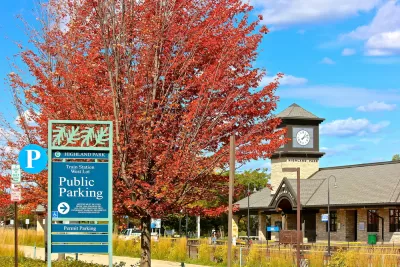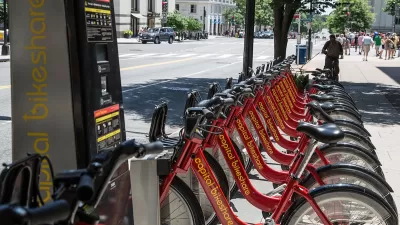If self-driving cars means more sharing and less car ownership, we may finally lose our appetite for parking, even in the motor city.

John Gallagher of The Detroit Free Press argues that the city of Detroit and its suburbs has been "disfigured" by parking lots, but he hopes that changes in technology and the city could alter that. "Most proponents of autonomous vehicles predict we’ll need a lot fewer parking spaces in the future because driverless cars will not need to park at all, except at night," Gallagher writes. He hopes that many people would share a single driverless car and rather than sitting idle, taking up space on a lot, shared cars would replace several cars by driving around picking up multiple people and running them to and from wherever they need to go.
Still, Gallagher writes, ride hailing services and the expansion of public transit has not yet saved Detroit from parking lot fever. "If anything, recent trends have pushed up — rather than reduced — demand for parking in Detroit and in suburban downtowns such as Birmingham and Ferndale," Gallagher reports.
FULL STORY: Self-driving cars, QLINE and bikes could leave parking lots empty

Study: Maui’s Plan to Convert Vacation Rentals to Long-Term Housing Could Cause Nearly $1 Billion Economic Loss
The plan would reduce visitor accommodation by 25,% resulting in 1,900 jobs lost.

North Texas Transit Leaders Tout Benefits of TOD for Growing Region
At a summit focused on transit-oriented development, policymakers discussed how North Texas’ expanded light rail system can serve as a tool for economic growth.

Why Should We Subsidize Public Transportation?
Many public transit agencies face financial stress due to rising costs, declining fare revenue, and declining subsidies. Transit advocates must provide a strong business case for increasing public transit funding.

How to Make US Trains Faster
Changes to boarding platforms and a switch to electric trains could improve U.S. passenger rail service without the added cost of high-speed rail.

Columbia’s Revitalized ‘Loop’ Is a Hub for Local Entrepreneurs
A focus on small businesses is helping a commercial corridor in Columbia, Missouri thrive.

Invasive Insect Threatens Minnesota’s Ash Forests
The Emerald Ash Borer is a rapidly spreading invasive pest threatening Minnesota’s ash trees, and homeowners are encouraged to plant diverse replacement species, avoid moving ash firewood, and monitor for signs of infestation.
Urban Design for Planners 1: Software Tools
This six-course series explores essential urban design concepts using open source software and equips planners with the tools they need to participate fully in the urban design process.
Planning for Universal Design
Learn the tools for implementing Universal Design in planning regulations.
Ascent Environmental
Borough of Carlisle
Institute for Housing and Urban Development Studies (IHS)
City of Grandview
Harvard GSD Executive Education
Toledo-Lucas County Plan Commissions
Salt Lake City
NYU Wagner Graduate School of Public Service





























